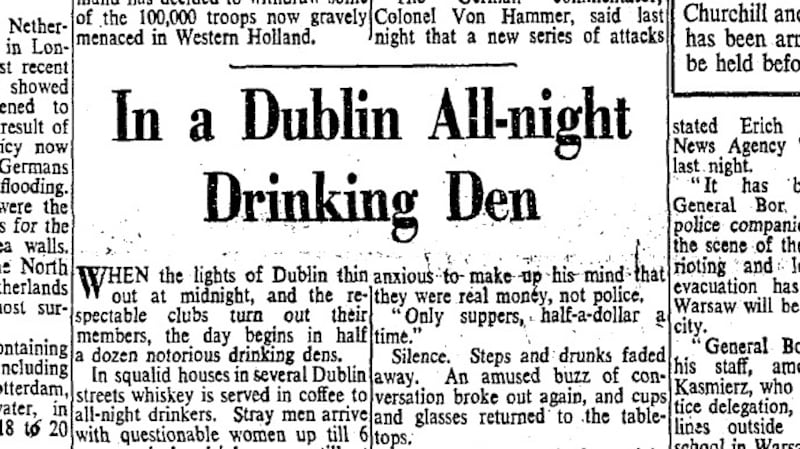In 1940s Dublin, the pubs closed early. That didn't mean you couldn't keep drinking, as one intrepid Irish Times contributor wrote on the paper's front page on October 7th, 1944.
“When the lights of Dublin thin out at midnight, and the respectable clubs turn out their members, the day begins in half a dozen notorious drinking dens,” writes the anonymous reporter.
Once the regulated establishments in the city closed, a different class of refuges opened their doors to those seeking a tipple. Access was gained through a knock on a shutter and after a mini interrogation, liquor was served under the guise of coffee.

To get a flavour of exactly what went on, the writer joined the “stray men” and “questionable women” of Dublin city at one of these secret drinking rooms.
“It was like something from an American film, of the ‘dry’ days, with passwords, and constant clearing of tables at each knock,” writes the mole, who adds “we found ourselves in an unbelievably queer room, which passed for an indifferent cafe in daylight. The waiter locked the door after us”.
“Roughly, a dozen small tables lined the walls and ran down the centre. A dozen people, all in a tipsy condition, produced cups and glasses from under the tables, and returned to a buzz of conversation.”
“They sat in pairs, men and women, except for one elderly man, who lay slumped over a table in best detective story fashion, dead—but dead drunk.”
Ordering drinks was a shifty process.
“My friend asked for coffee, and through a process of semi-sign talk the coffee arrived at 1s 6d a cup — 6d for the coffee, 1s for the additional contents. Subsequently whiskies were supplied in glasses, but the customer emptied these into coffee, and the glasses were quickly cleared away.”
The inevitable whiskies
After the writer received his drink, there was a knock at the door, prompting the waiter - who was swaying and “half-drink” himself - to ask patrons to clear the evidence: “Glasses under the table,” was the call.
Glasses were removed from sight, even the coffee cups, defeating the purpose of drinking out of a cup in the first place: “. . . most were too intoxicated to appreciate the comparative immunity of the coffee cup”.
“Between 3 and 5(am), eight stragglers were admitted. Even on the point of 5am a middle-aged man and his love-of-the-night came in. They sat down, and were served with a handsome breakfast of coffee, eggs and bacon, cooked in an inner kitchen by a young man. Along came the inevitable whiskies, and as the safer morning hours approached the glasses remained on the tables.”
After sunrise, the city’s early workers went about their business. The milkman came and the newsboy sold papers to the “diners”.
As the session wore on and the drinkers drank, nobody was getting much worse for wear. As the reporter’s friend put it: “A small whiskey and a bucket of water does this place for a night.”
The spirits were “watered down to suit the customer’s state of intoxication—a little stronger when he seems too sober, a little weaker when he looks like becoming a sleeping partner”.
“The den described here, with its prostitute hangers-on, its semi-secret entrance formula, its cups and glasses under the table, is only one of several Dublin drinking dens, higher up and lower down the scale,” the writer informs us, before delivering a parting blow to the speakeasy regulars.
“They are not, in general, frequented by young people, most of whom do their late drinking through the private house-party, but they are traps for the unwary youngster who comes to the city on his own, finds himself out late at night, feels like drinking, and has no friends.
“Investing drink with adventure in a false atmosphere, they lead to excess, especially where the ‘customers’ bring their own supplies with them.
“Judging from the type of woman present, they are easy stepping stones to disease.”
The above story is part of the 'Lost Leads' series - a re-visiting of lesser-known stories that have made the pages of The Irish Times since 1859. What can you find? Let us know on twitter @irishtimes. For more information on subscribing to the archive, click here: http://www.irishtimes.com/archive









